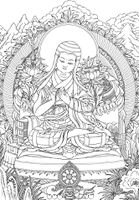Sa skya paN+Di ta
| Wylie | sa skya paN+Di ta |
|---|---|
| English Phonetics | Sakya Paṇḍita |

- ཀུན་དགའ་རྒྱལ་མཚན་
- ས་སྐྱ་པཎྜི་ཏ་ཀུན་དགའ་རྒྱལ་མཚན་
- kun dga' rgyal mtshan
- sa skya paN+Di ta kun dga' rgyal mtshan
- Sapaṇ
| Birth: | 1182 |
|---|---|
| Death: | 1251 |
Tibetan calendar dates
| Day | |
|---|---|
| Month | |
| Gender | Male |
| Element | Water |
| Animal | Tiger |
| Rab Jyung | 3 |
- Religious Affiliation
- Sakya
- Familial Relations
- Grandson of Sa chen kun dga' snying po and nephew of rje btsun grags pa rgyal mtshan and bsod nams rtse mo, and uncle of chos rgyal 'phags pa.
- Teachers
- Kha che paN chen shAkya shrI · rje btsun grags pa rgyal mtshan
- Students
- gu ru chos kyi dbang phyug · chos rgyal 'phags pa · yang dgon pa rgyal mtshan dpal
Other Biographical info:
- BDRC Link
- https://www.tbrc.org/#!rid=P1056
- Treasury of Lives Link
- http://treasuryoflives.org/biographies/view/Sakya-Pan%E1%B8%8Dita-Kunga-Gyeltsen/2137
- Treasury of Lives Excerpt
- Himalayan Art Resources Link or Other Art Resource
- https://www.himalayanart.org/search/set.cfm?setID=325
- Wiki Pages
- Sa skya paN+Di ta on the DRL
- Sa skya paN+Di ta on the LIB
- Sa skya paN+Di ta on the DNZ
- Sa skya paN+Di ta on the BNW
- Person description or short bio
Expand to see this person's philosophical positions on Buddha-nature.
| Is Buddha-nature considered definitive or provisional? | |
|---|---|
| Position: | Provisional |
| Notes: | *Kano. K., Buddha-Nature and Emptiness, p. 309.
|
| All beings have Buddha-nature | |
| Position: | Qualified No |
| If "Qualified", explain: | There is some discrepancy between Sapen's use of the term tathagata-essence and buddha-nature and other thinkers that use these terms synonymously. In Sapen's view, sentient beings do not possess the former, but do possess a more general form of the latter. So while the answer is a qualified "no" in terms of the more general debate on this issue and the way others have addressed it and asserted Sapan's position, strictly speaking from Sapen's view the answer could more accurately be a qualified "yes" as he does state all beings have a basic "inherent" buddha-nature, though this does not correspond to an essence that is endowed with enlightened qualities. The tricky issue being the equivalency of these terms tathagata-essence and buddha-nature and the perception of the Sakya position by later authors. |
| Notes: | *"In verses 59-63 of Sapen's Distinguishing the Three Vows, he argues against the presentation of the existence of a tathâgata-essence or sugata-essence endowed with enlightened qualities in sentient beings. Sapen demonstrates that such a position would be tantamount to holding the view of the Sämkhya School, that the "result is present in its cause." Wangchuk, Tsering, The Uttaratantra in the Land of Snows, p. 27.
|
| Which Wheel Turning | |
| Position: | |
| Notes: | |
| Yogācāra vs Madhyamaka | |
| Position: | Madhyamaka |
| Notes: | |
| Zhentong vs Rangtong | |
| Position: | Rangtong |
| Notes: | predates the distinction but is clearly in line with rangtong |
| Promotes how many vehicles? | |
| Position: | |
| Notes: | |
| Analytic vs Meditative Tradition | |
| Position: | Analytic Tradition |
| Notes: | |
| What is Buddha-nature? | |
| Position: | Tathagatagarbha as the Emptiness That is a Nonimplicative Negation |
| Notes: | "An opinion shared by rNgog and Sapan is that Buddha-nature should be understood in the sense of emptiness. The difference is that rNgog directly equates Buddha-nature with emptiness, whereas Sa-pan regards the intentional ground (dgongs gzhi) of Buddha-nature to be emptiness." Kano. K., Buddha-Nature and Emptiness, pp. 309-310. |
| Svātantrika (རང་རྒྱུད་) vs Prāsaṅgika (ཐལ་འགྱུར་པ་) | |
| Position: | Prāsaṅgika (ཐལ་འགྱུར་) |
| Notes: | |
| Causal nature of the vajrapāda | |
| Position: | |
"Tathagatagarbha as the Emptiness That is a Nonimplicative Negation" is not in the list (Tathāgatagarbha as Mind's Luminous Nature, Tathāgatagarbha as the Unity of Emptiness and Luminosity, Tathāgatagarbha as a Causal Potential or Disposition (gotra), Tathāgatagarbha as the Resultant State of Buddhahood, There are several types of Tathāgatagarbha, Tathāgatagarbha as the Emptiness That is a Non-implicative Negation (without enlightened qualities), Tathāgatagarbha as the Emptiness That is an Implicative Negation (with enlightened qualities), Tathāgatagarbha as the Latent State of Buddhahood that is Obscured in Sentient Beings, Tathāgatagarbha was Taught Merely to Encourage Sentient Beings to Enter the Path) of allowed values for the "PosEmptyLumin" property.